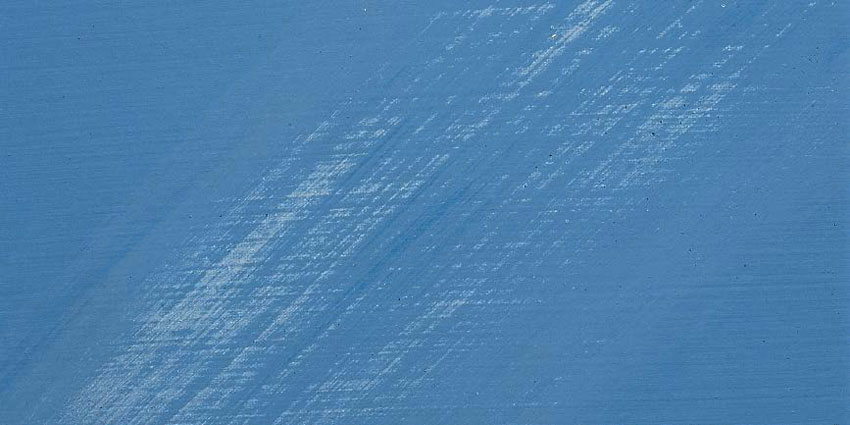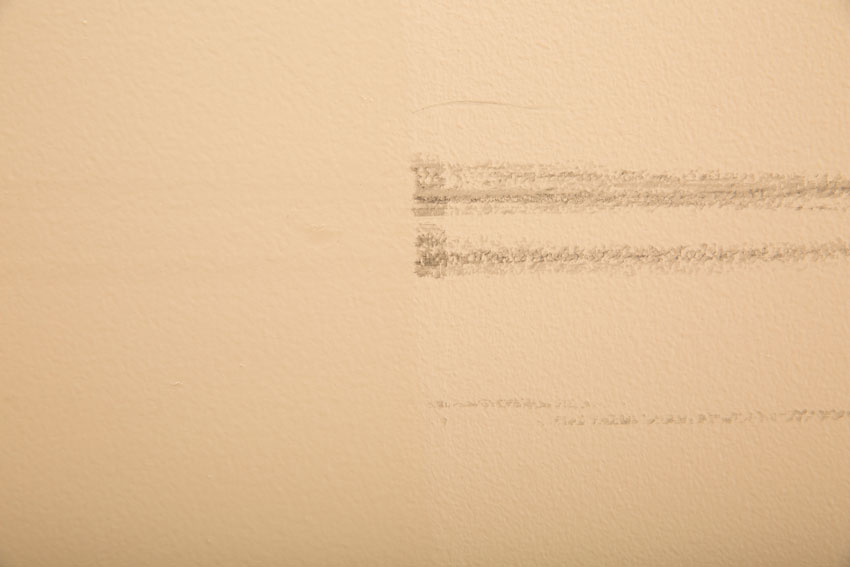Scuff-Resistant Paint: Long Term Durability, Low Maintenance
Scuff Resistance vs. Scrub Resistance
As noted above, constant wear and tear in high-traffic environments leaves daily marks. This creates an inherent dilemma. The surfaces must frequently be cleaned and scrubbed, often with conventional cleaners, to try to remove severe stains and scuffs.
But the cleaning itself causes damage. Cleaning and scrubbing are mechanical processes that remove not only the marks but, in most latex paints, also molecules of paint, eventually wearing away the paint film. Many conventional latex paints used in high-traffic areas may be subject to “burnishing,” a disfiguring increase in sheen creating an uneven appearance (see image below) in paint that has repeatedly been rubbed, particularly by frequent washing and spot cleaning. Burnishing occurs most often in flatter finishes and deep colors, but some paints may burnish in both light and dark colors. Sooner or later, burnishing will require retouching and then repainting. Depending on the characteristics of the space and the paint, “sooner” can be within months.

Paint that is repeatedly rubbed, particularly during cleaning and scrubbing, develops a disfiguring, uneven appearance called “burnishing.”
As a result, one of the primary characteristics of paint selected for high-traffic environments has been its scrub resistance, reflecting the reality of the need for frequent cleaning. The assumption is that the marks will have to be scrubbed off the surface. Removing the marks involves some level of mechanical erosion of the paint film.
Scrub resistance is a paint’s ability to withstand the scrubbing necessary to remove stains or marks with no changes to the coating’s appearance or its protective functions. Scrub resistance is measured in scrub cycles and scrub ratings, determined by a test method in ASTM D2486. Dried paint samples are repeatedly scrubbed with an abrasive brush until the surface of the paint deteriorates. A high scrub rating indicates that the paint will hold up to frequent abrasive cleaning longer than a paint with a lower rating before it is physically damaged.
This is an attribute of paints in high-traffic environments. However, coatings such as two-component and pre-catalyzed epoxies with higher scrub cycles do not reliably resist scuffs and marks.
In contrast, the technology in scuff-resistant waterborne latex paint takes an entirely different approach. It creates a surface that resists the scuffs and marks. Contact from people and objects that would leave marks on conventional commercial and industrial paints does not adhere to scuff-resistant paint. If scuffs appear at all, they wipe away easily with soap and water—without scrubbing. Less cleaning, retouching, and repainting is required, which lowers the total maintenance cost.

The left side of the sample board was painted with scuff-resistant latex paint and the right side with a two-component scrub-resistant paint. Both sides suffered repeated scuffing, but the left side of the sample board with scuff-resistant paint does not show it.
In addition to the reduction in the cost of maintenance, the scuff-resistant paint solves another challenge in high-traffic environments. By definition, these places are constantly used by many people, so closing them for extended periods is difficult for the businesses and activities that are operating there, and in some cases, such as hospitals, nearly impossible. Scuff-resistant paint dries to the touch in an hour and can be recoated in 2–3 hours and rapidly returned to service. Downtime and disruption are minimized.
Comparing Coatings Used in High-Traffic Environments
Architectural coatings have evolved rapidly in recent years. Only a few years ago, extended durability in demanding applications was only available in formulas that were complicated to mix and apply and contained high levels of VOCs. Intense research and pressure for more environmentally responsible, more versatile paints led to improved formulas.
Paints can be compared in a number of ways—by their resin, curing mechanism, function, thinner type, use, or finish. Coatings for high-traffic and other demanding applications have been developed to solve a range of problems. The primary division is between solvent-based and waterborne applications, although many hybrid types also exist.
This course focuses on waterborne formulas specifically developed for high-traffic environments. Latex coating systems have inherent advantages, including good gloss retention and superior resistance to fading, yellowing, and rub-off. They can also be engineered for superior stain blocking, durability, and flexibility.
Current paint options recommended for high-traffic areas where durability is a key factor include: conventional latex coatings (often used in higher sheens like eggshell and semi-gloss), two-component systems, pre-catalyzed, and scuff-resistant paint. Each of these has specific characteristics that can meet a project’s specific needs. Often, these needs can vary even among different areas within the same project.








